
6 Types of Email Newsletters (With Examples of Content and Audience)
Table of Contents
What’s Your Type, Huh?
The whole table chuckled and a friend even spilled his juice as I stoically replied, “definitely curated, full of GIFs, and with a funny footer.”
I only realized seconds later that the question was ‘so, what’s your type?’ and it was definitely not related to newsletters. Well, launching my newsletter is the only kind of commitment I am into right now so in my defense, it was a valid answer.
But, I thought about it seriously. I have looked at an awful lot of newsletters, and some beautiful email newsletters. How many types of newsletter are there?
A lot. But there are some commonalities too. Read on to know more about types of newsletters and most importantly, what type goes well with what kind of audience and content. You will also find some great newsletter content examples.
Sharing User-generated Content
This kind of newsletter is possible for a platform that is generating quality content from its users on a daily basis. A very good example is the blogging website Medium.

It requires complex algorithms and tracking user’s interaction with the platform. The quality of content is based on the creators of the platform and that in turn affects the behavior of the consumers.
Frequency of sending
Usually, it is based on the subscriber’s preference - daily, weekly or monthly. You don't have to worry about that if your automations are in place.
How to curate such a newsletter
Usually, it is curated based on the subscriber’s interest and past interaction with the platform. It can also contain some featured articles handpicked by the editor.
A good strategy is to categorize content so the subscriber knows why they are receiving certain links & can choose what they would like to read on any particular day. If you don't want to keep content creation in-house, consider working with a SaaS content writing firm that will make it more professional.
What type of business is this best suited for?
It’s good for platforms where users are actively generating quality content daily. For instances, iGaming or Crypto require very high engagement. It’s good for boosting Daily Active Users (DAUs) or Monthly Active Users (MAUs) of the platform or app.
When people see other’s content being sent out to thousands or millions of people on the platform’s list, it also motivates them to transition from consumers to creators. And this basically creates a flywheel for the platform.
Driving Organic Views to Website
This is mostly created or crafted newsletter. As opposed to a curated newsletter that shares links from outside sources and sends traffic to them, a created newsletter sends traffic to its own website or blog.
This is for someone who can write clearly & beautifully. If you want to send a created newsletter and can write well, that’s great. Go for it. If you are not sure about your writing skills but have some thought-provoking, illuminating ideas I would say hire someone who can write for you.
Don’t send multiple blogs in a single newsletter. You can keep it to a maximum of 2 blog snippets or 1 full blog. Anything more than that from the same niche would overwhelm your audience.
Frequency of sending
It would be very tiring to send a blog every day so a weekly email works best. However, if you are a company with writers and editors working solely on the blog post, then you can send it every day too.
Such newsletters carry the writer’s reputation with them so if you see that your quality is getting compromised when you send it weekly, switch to monthly. You can always experiment & see what works best.
How to create such a newsletter
It can contain snippets from your blog & leads on to your website once it reaches a point of curiosity. You can see in this example from John P. Weiss’s newsletter.
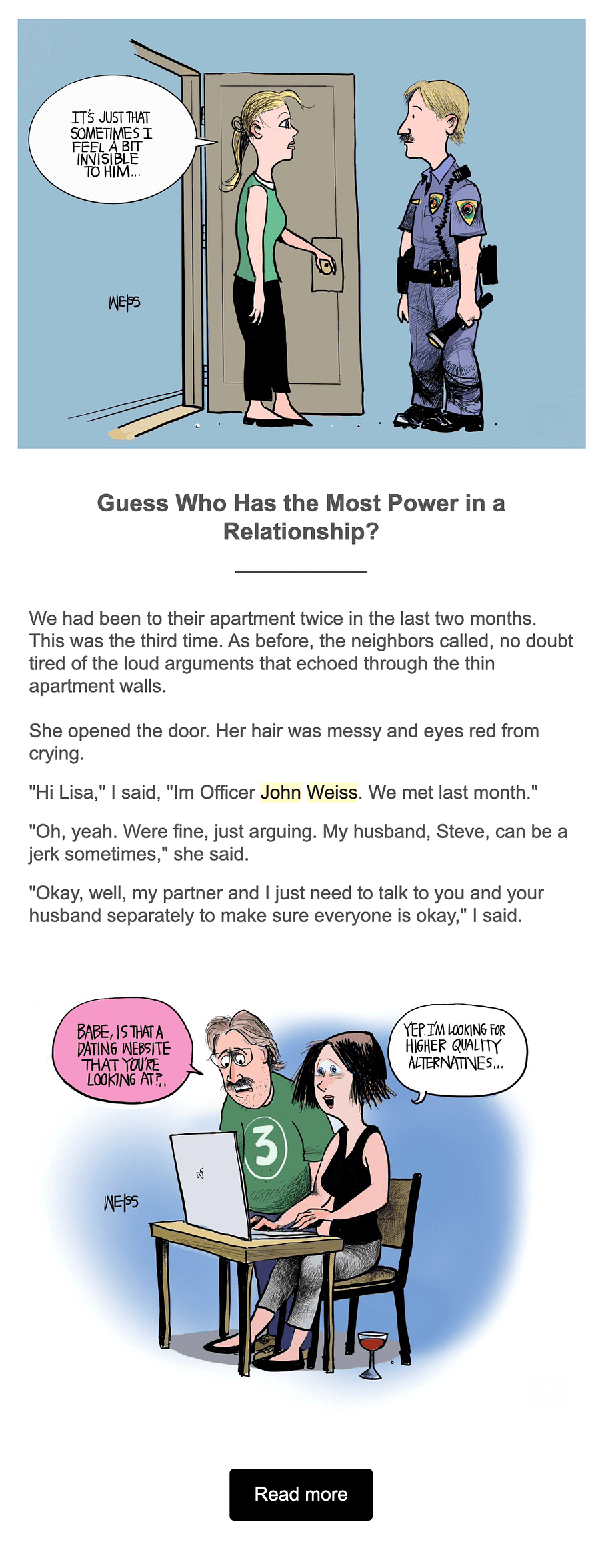
Or it can contain a story or narrative that leads people to click the CTA button on your blog. A great example is Cole Schafer’s email newsletter by the name ‘Sticky Notes'.

As a bonus, you can include creative CTAs like how Cole does it the example above (and not the boring ones with ‘Click Here’ or ‘Read Here’).
What type of business is this best suited for
The great thing about such types of newsletter is that it’s not dependent on anyone else generating content or size of your list to be meaningful.
It’s good to send a blog type newsletter whether you have 10 or a million subscribers.
For example, Nat Geo also sends a similar kind of newsletter to its millions of subscribers. And Cole, a solopreneur is also sending the newsletter to his few thousand subscribers.
Few examples of newsletters in that newsletter category:
Sticky Notes
John P. Weiss
The Ken
Sketchplanations
Promoting Listings From Your Platform
These are basically emails containing what new listings have come-up on the platform. It sends traffic to its own website & links are shared on the basis of what’s available & what’s new rather than user’s preference.
A platform is just an efficient form of an ancient style bazaar. Basically, it is a place where people who have something to offer showcase and people who need that something come to check out what’s available.
And to make it more efficient, platforms introduced newsletters.
Because you know, you might not remember to check it out when you actually need it! (Like how you never find that perfect white shirt when you need it). So they keep reminding you, ‘hey, we are her if you want to check out something.’
Have you seen a platform that is built from a simple email list & newsletter, and then its newsletter becoming even more popular? That’s Product Hunt for you. More importantly, see the power of a newsletter.
Another great example is Key Values by Lynne Tye where she also shares a story about her life before she shows you the listings on her platform.

This also shows that it doesn’t have to be about the platform all the time.
Remotive’s newsletter shares highly relevant content for remote workers, focusing on productivity and hacks, along with remote job offers posted on its website, which is certainly contributing to Remotive’s success: 20,000+ subscribers!
Frequency of sending
The frequency depends on the volume of listings being generated on your platform. If you don’t have a huge volume of new listings every day, it won’t make sense to bombard people with email every day.
Key Values sends one email per week while Product Hunt give you an option to choose your preference - daily or weekly.
How to create such a newsletter
To put together this newsletter, you basically have to collect the relevant links and write why someone should check those. You basically have to be an advocate of someone else’s product.
You can also run a promotional section in your newsletter where you post a sponsored listing. That way you can even keep the platform and newsletter free for your audience.
The best part is, by virtue of having a platform you are already sitting on a pile of emails you received when people logged in to your platform. C’mon, quit being shy and share your awesome newsletter with them.
What type of business is this best suited for?
This is best suited for digital platforms - a place where businesses can easily connect with their customers, or suppliers or network. Basically where they can plug their business into yours and co-create value.
If your business gathers enough people from the same niche, working in a similar industry you should be able to get subscribers and kick off that newsletter.
Curating Content From Outside Sources
Do you read voraciously, watch thoughtful/informative videos every day? Is your phone gallery overtaken by the many screenshots of interesting, funny, weird information?
If you have been in this situation, I am sure you also would have thought - Why can’t someone just put all these links together and send me?
Well, that’s what curated newsletters are for.
Here is a curated weekly newsletter from Austin Kleon:

The writers find, organize and share the best and relevant content related to a particular topic or some broad niche. It’s like creating a cheese platter. (don’t run for wine yet, finish reading more awesome things coming further)
This is probably the most popular category of newsletters used by companies as well as individuals.
Why?
It doesn’t require you to be a good writer. Saves a ton of time, too. You can choose from a vast pool of content, keeping a wider range of audience engaged.
But, don’t send links out of context or without explaining why you are sharing that. That’s the value you are providing here - sending them a collection and helping them choose from your collection.
Some Folks curating evergreen newsletters
Farnam Street
5-Bullet Friday
Austin Kleon
Companies sharing curating newsletters
The Hustle
Morning Brew
Frequency of sending
You can send it daily if your area of focus is daily news. Because that’s going to go stale if you wait till the weekend.
If you are sending evergreen content, you can experiment with segmentation. You basically segregate your email list and send emails according to their open rates & interactions.
If you want to try out this feature, you can take a 14-day free trial of SendX and the good folks will help you set up, segment & test the experiment.
Did I mention no credit card required to sign up? Yup, that’s true.
How to create such a newsletter
You should read a lot or watch interesting videos online. Then judge if this is something not many people are aware of. After this you evaluate if this will resonate with your audience. If yes, then write a short snippet about it and put it with the link.
You can contact brands to promote their product but be honest & careful with this approach. Don’t promote something you haven’t tried well. People have a sensitive BS sensor and they will sense if you try to ‘sell’ them.
What type of business is this best suited for?
Literally everyone can do curated content as long as we have the ratio of created to curated maintained in the world. But the industry for which it makes the most sense is - News industry. Because they can’t (& shouldn’t) create content in-house.
If you are in an industry that’s changing very quickly - like SEO and how Google works (it’s not a joke, it does change quickly), this kind of newsletter can provide great value to people.
Or if your niche is something like ‘Book club’ where you of course can’t publish a book every week, then you should do a curated newsletter linking to amazing books out there.
Focused On an Industry or Product
Some newsletters are focused on helping people get better at what they do.
They are a great way to build relationships with people who are not yet your customers, but someday they can be. They help you engage with people who belong to the same industry but might be using a competitor’s product or still on the edge to try out yours.
They can be both curated and created but rather than abstract or wide (very wide) topics like ‘life’, they are solid, digestible information pieces that focus on specific questions people in an industry are asking.
Two amazing examples are - InVision & Help Scout.
InVision is a digital product design platform and its newsletter focuses on information that educates its audience. It’s more than a ‘how-to’ newsletter. The links which take you to Invision’s own blog talk about design accessibility, design maturity, etc.

Their footer promotes the platform very subtly.
Help Scout, a customer service platform has 70,000+ subscribers to its newsletter. I am not surprised after looking at how short & succinct their copy is. They focus on one topic per newsletter and get their key message across in the most simple way.
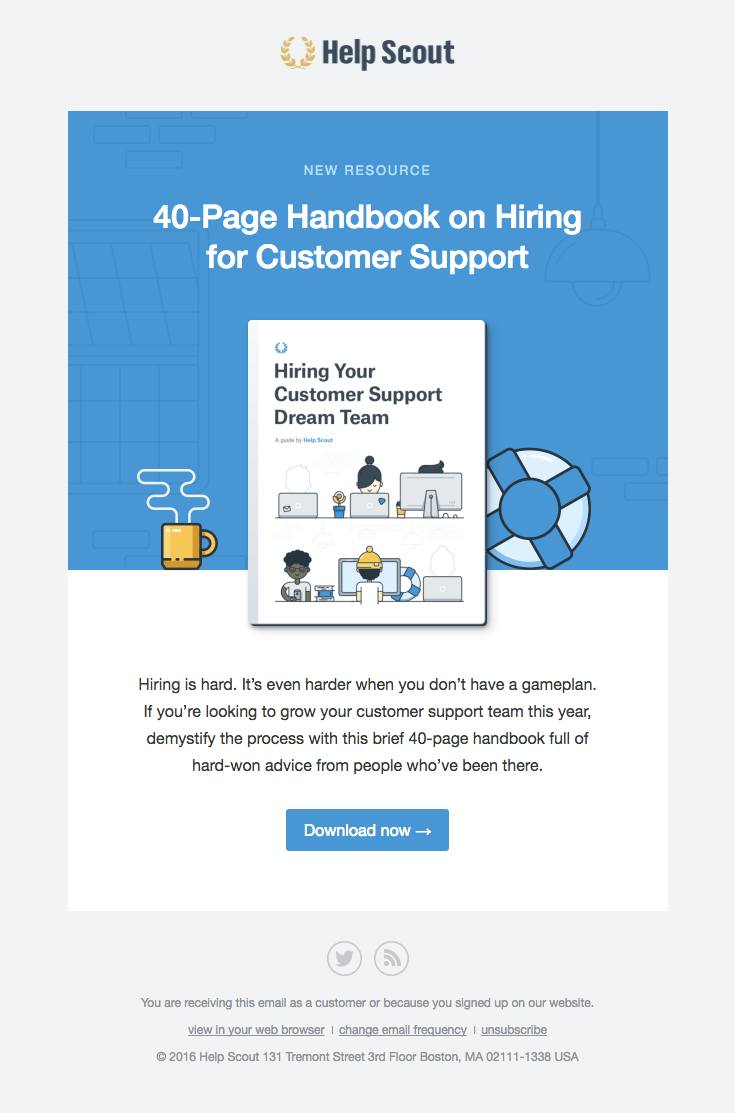
Frequency of sending
A weekly or monthly would be great. Since the topic is very niche, a daily newsletter would be overkill.
How to create such a newsletter
To create such newsletters, you have to be in touch with your customers and even non-customers, basically, your whole industry. Find out where your potential customers are hanging out and what kind of questions are they asking. Then you dive deep into answering those.
Usually, the perception is that if you are a product company your newsletter is going to be boring. So put some effort into making it delightful.
What type of business is this best suited for?
If your business involves a mindset that’s thinking beyond your product, it’s a great move to share your thoughts with a newsletter.
You can launch this if you have any kind of product that you are building - be it digital or physical. It works well if your brand has a very targeted audience, it has a character, good reputation and a community of people following it.
It can also work the other way round where you start the newsletter and try to build a community of people interested in the same thing.
Promotional Newsletters
These are created to increase brand recall and ask people to take any action that involves a sale. These are not very common and very few companies do them well.
But the ones that do them well prove that you can promote without being too pushy.
A travel company, Byond does it beautifully.

I see you rolling eyes & thinking ‘yeah, but that’s a super interesting category so they can do it’
Moo does it. Harry’s does it. These are physical goods companies.
Look at these examples:
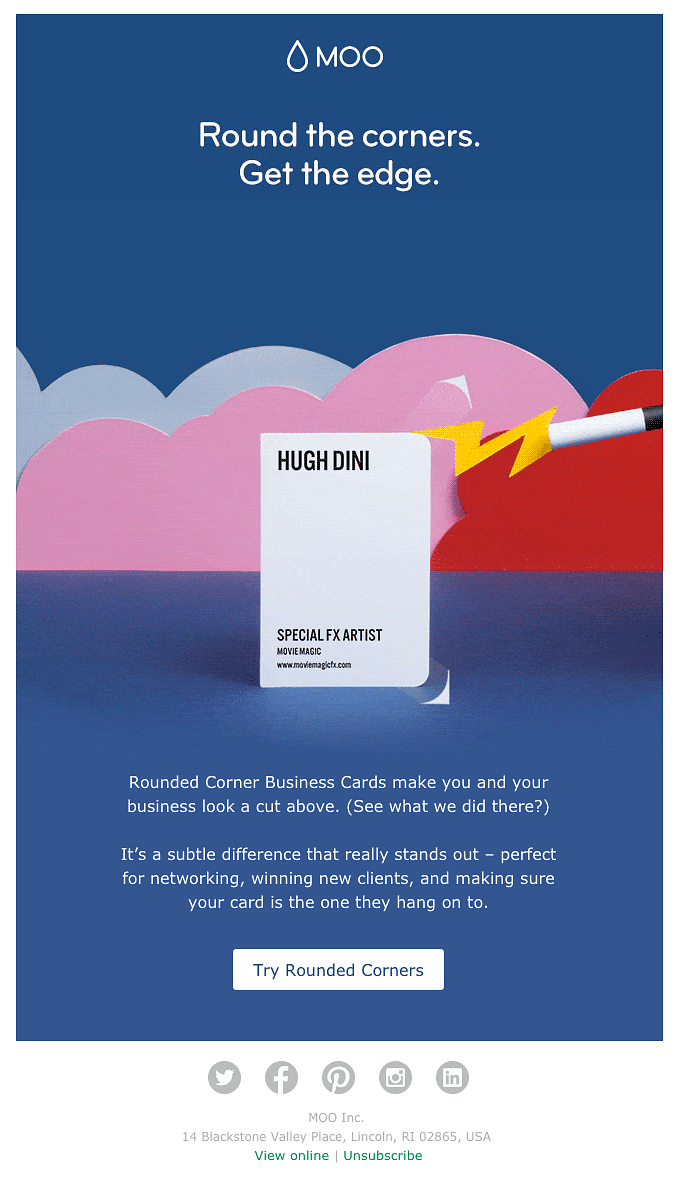
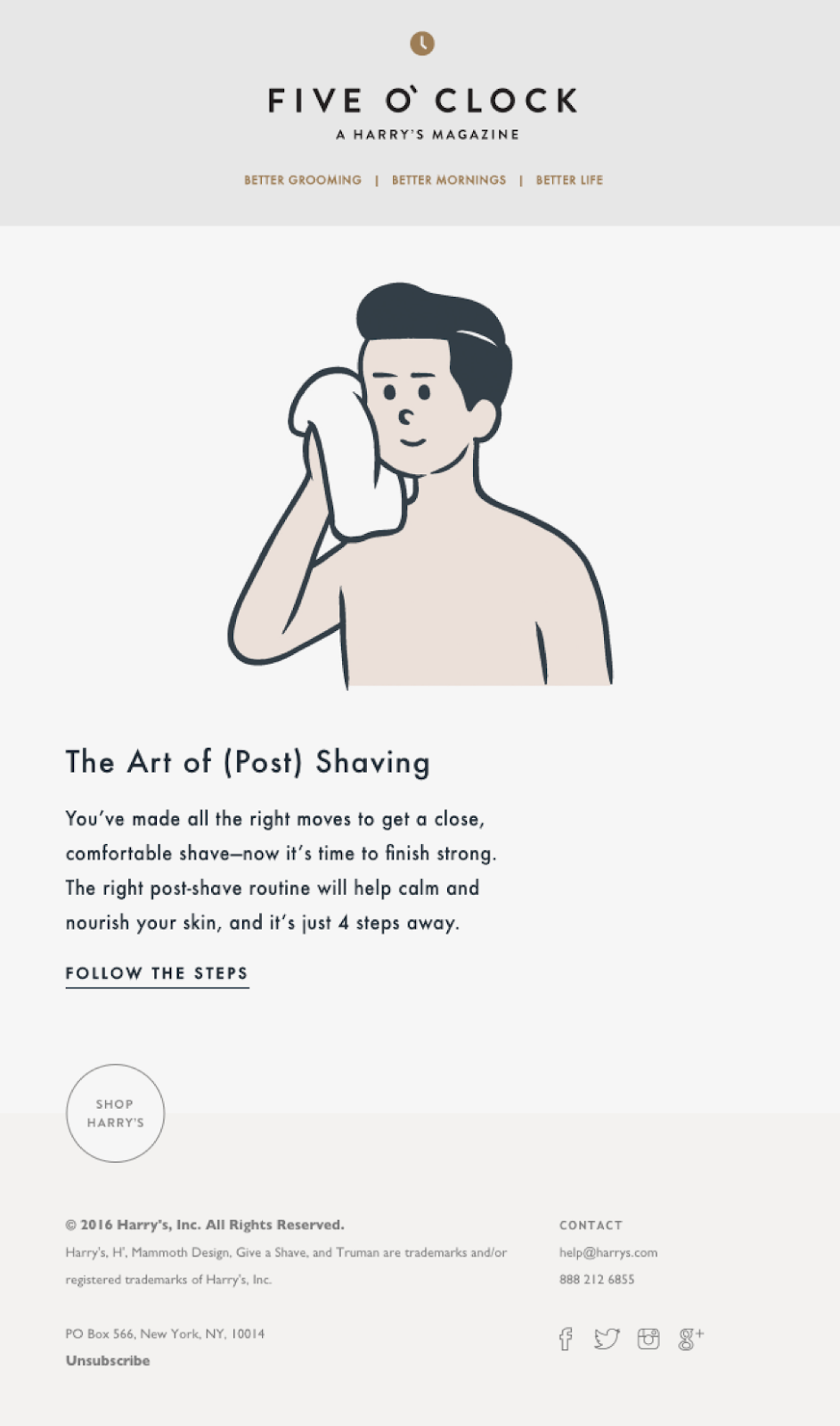
Frequency of sending
Since these are sales emails, definitely not every day. I would say once in two weeks would be good if you know how to create interesting content around your brand.
How to create such a newsletter
Think about how your product integrates into people’s lives and how you can show them better ways to do that. The focus should be on people and their situations. Then you should plug in your product there.
Don’t use sales-y CTAs like Buy Now, Enroll Now. These can push people away from clicking any links. Your first motive should be to get people to click the button and then let your landing page or sales page do the job.
What type of business is this best suited for?
This would be great for an e-commerce platform, small merchandising companies run by artists themselves. I have seen it done well for online course companies as well, like how Mindvalley does it.
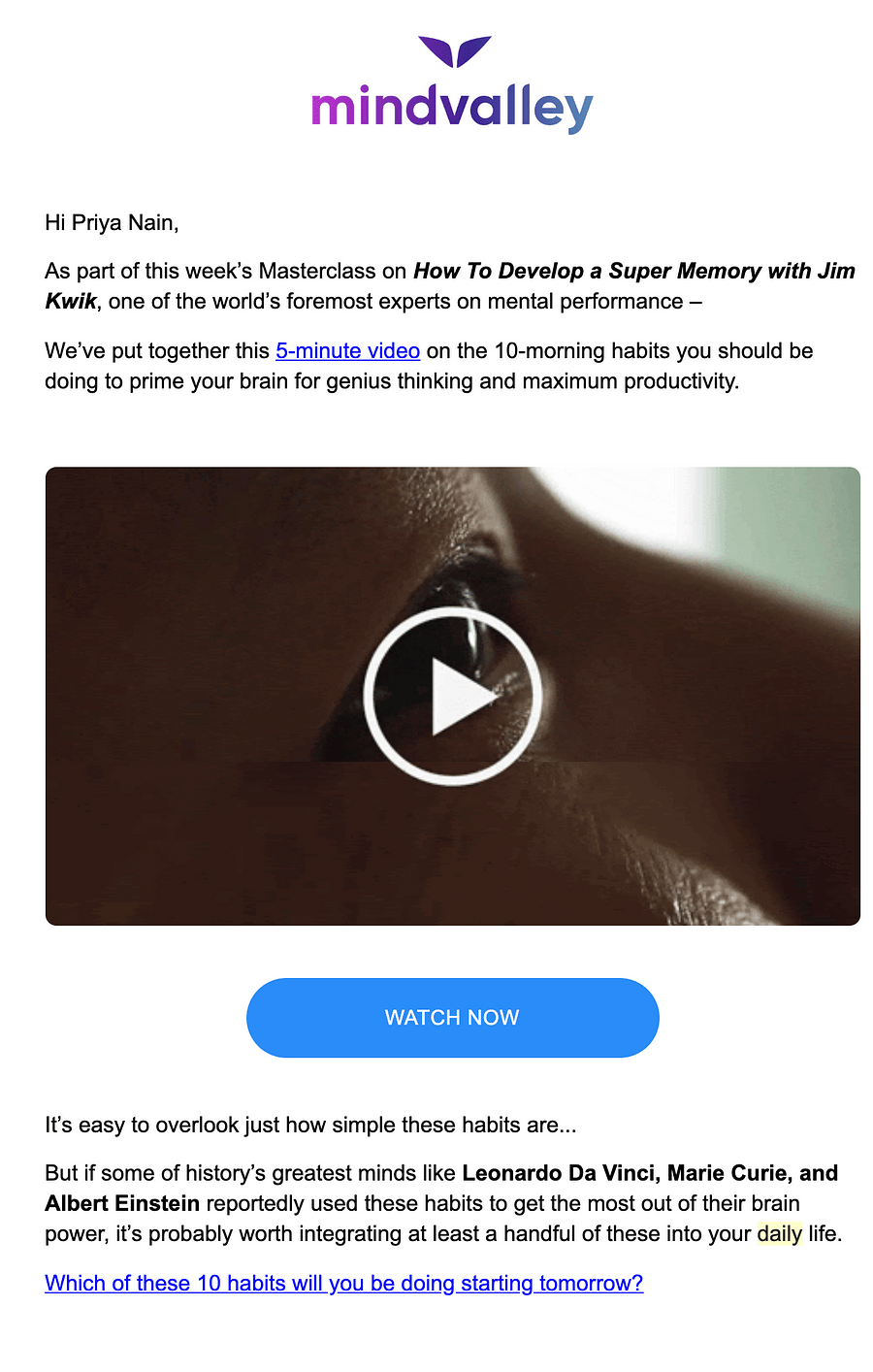
They provide you valuable content that you are convinced to go checkout their sales page. And they don’t hesitate to put many links telling you where exactly the sales page is.
Wrapping Up
I don’t know what’s your type but you can always take inspiration from all the types out there. No two newsletters are exactly the same & there is no right or wrong way to make one.
Be sure to test a variety of content that is valuable to your target audience, and give them options when it comes to how they digest that content. Promote your business or build your personal brand, fearlessly. But always give a lot of value before you ask for something in return.
It’s great that you are thinking about your email marketing strategy. After nailing down your draft of the newsletter, I am sure you will move on to the processes, systems, and software to send out this creation.
Don’t get overwhelmed.
You will find a variety of options but you should always choose something that is affordable & easy to use. That’s why I would humbly suggest you try SendX for 14 days for FREE. You don’t even need a credit card for it!
And yes, remember to have fun & let us know your type in the comments section.
FAQs
1) What are the different types of email newsletters?
There are different ways to classify this. From the point of view of what an email newsletter should can help achieve, here are few classifications:
- Driving views to your own website or blog.
- Promoting the new listings on your platform.
- Curating content from outside sources.
- Engage with people who belong to your target niche but are not yet using your product or service.
- Promotional newsletters.
2) What is the difference between a curated newsletter and a crafted newsletter?
A curated newsletter mostly shares links from outside sources and sends traffic to them, whereas a created newsletter sends traffic to its own website or blog.
3) How frequently should I send an email newsletter?
A weekly newsletter is what most will be happy to receive. But it also depends on your writing and editing bandwidth. In whichever case, it should be not more than twice a week, and at least once a month.
4) How can I measure the success of my email newsletter?
The core metrics by which you can measure the success of your email newsletter are 'delivery rate', 'open rate' and 'unique click rate'.
- Delivery rate is the ratio of the number of emails that didn't bounce to the number of emails sent.
- Open rate is the ratio of the number of people opening to the number of emails delivered.
- Unique click rate is the ratio of people who clicked links to the number of emails delivered.
5) How can I ensure that my email newsletter displays correctly even on mobile devices?
SendX has a drag and drop, WYSIWYG Editor that shows an instant preview of your email newsletter for mobile and desktop screen sizes. This way you know for sure how well your email looks on mobile screens as well.
6) Do we need special email designing skills to create a good newsletter in SendX?
No. With the WYSIWYG drag and drop editor in SendX, you can design beautiful email newsletters even if you don't know HTML. And, SendX offers 50+ free response email templates as well.


